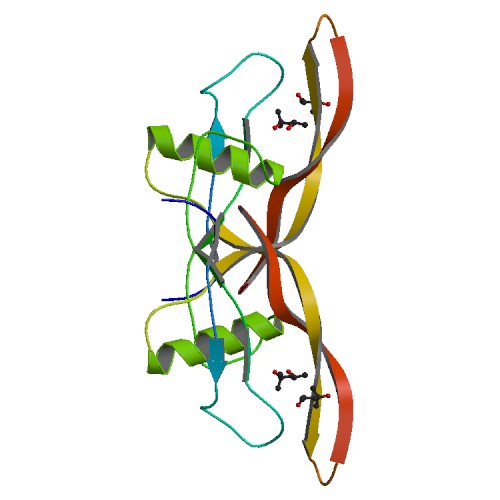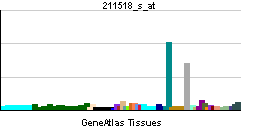Bone morphogenetic protein 4
Bone morphogenetic protein 4, also known as BMP4, is a human gene.
The protein encoded by this gene is a member of the bone morphogenetic protein family which is part of the transforming growth factor-beta superfamily. The superfamily includes large families of growth and differentiation factors. Bone morphogenetic proteins were originally identified by an ability of demineralized bone extract to induce endochondral osteogenesis in vivo in an extraskeletal site. This particular family member plays an important role in the onset of endochondral bone formation in humans, and a reduction in expression has been associated with a variety of bone diseases, including the heritable disorder Fibrodysplasia Ossificans Progressiva. Alternative splicing in the 5' untranslated region of this gene has been described and three variants are described, all encoding an identical protein.[1]
BMP4 is a polypeptide belonging to the TGF-β superfamily of proteins. It, like other bone morphogenetic proteins, is involved in bone and cartilage development, specifically tooth and limb development and fracture repair. It has been shown to be involved in muscle development, bone mineralization, and uteric bud development. BMP4 has also been implicated in Fibrodysplasia Ossificans Progressiva in which it is underexpressed.
In human embryonic development, BMP4 is a critical signaling molecule required for the early differentiation of the embryo and establishing of a dorsal-ventral axis. BMP4 is secreted from the dorsal portion of the notochord, and it acts in concert with sonic hedgehog (released from the ventral portion of the notochord) to establish a dorsal-ventral axis for the differentiation of later structures.
BMP4 stimulates differentiation of overlying ectodermal tissue. Inhibition of the BMP4 signal (by chordin, noggin, or follistatin) causes the ectoderm to differentiate into the neural plate. If these cells also receive signals from FGF, they will differentiate into the spinal cord; in the absence of FGF the cells become brain tissue.
References
Further reading
- Wozney JM, Rosen V, Celeste AJ; et al. (1989). "Novel regulators of bone formation: molecular clones and activities". Science. 242 (4885): 1528–34. PMID 3201241.
- van den Wijngaard A, Weghuis DO, Boersma CJ; et al. (1995). "Fine mapping of the human bone morphogenetic protein-4 gene (BMP4) to chromosome 14q22-q23 by in situ hybridization". Genomics. 27 (3): 559–60. PMID 7558046.
- Oida S, Iimura T, Maruoka Y; et al. (1995). "Cloning and sequence of bone morphogenetic protein 4 (BMP-4) from a human placental cDNA library". DNA Seq. 5 (5): 273–5. PMID 7579580.
- Rosenzweig BL, Imamura T, Okadome T; et al. (1995). "Cloning and characterization of a human type II receptor for bone morphogenetic proteins". Proc. Natl. Acad. Sci. U.S.A. 92 (17): 7632–6. PMID 7644468.
- Nohno T, Ishikawa T, Saito T; et al. (1995). "Identification of a human type II receptor for bone morphogenetic protein-4 that forms differential heteromeric complexes with bone morphogenetic protein type I receptors". J. Biol. Chem. 270 (38): 22522–6. PMID 7673243.
- Yamaji N, Celeste AJ, Thies RS; et al. (1995). "A mammalian serine/threonine kinase receptor specifically binds BMP-2 and BMP-4". Biochem. Biophys. Res. Commun. 205 (3): 1944–51. doi:10.1006/bbrc.1994.2898. PMID 7811286.
- Harris SE, Harris MA, Mahy P; et al. (1994). "Expression of bone morphogenetic protein messenger RNAs by normal rat and human prostate and prostate cancer cells". Prostate. 24 (4): 204–11. PMID 8146069.
- van den Wijngaard A, van Kraay M, van Zoelen EJ; et al. (1996). "Genomic organization of the human bone morphogenetic protein-4 gene: molecular basis for multiple transcripts". Biochem. Biophys. Res. Commun. 219 (3): 789–94. doi:10.1006/bbrc.1996.0312. PMID 8645259.
- Nishitoh H, Ichijo H, Kimura M; et al. (1996). "Identification of type I and type II serine/threonine kinase receptors for growth/differentiation factor-5". J. Biol. Chem. 271 (35): 21345–52. PMID 8702914.
- Bonaldo MF, Lennon G, Soares MB (1997). "Normalization and subtraction: two approaches to facilitate gene discovery". Genome Res. 6 (9): 791–806. PMID 8889548.
- Shore EM, Xu M, Shah PB; et al. (1998). "The human bone morphogenetic protein 4 (BMP-4) gene: molecular structure and transcriptional regulation". Calcif. Tissue Int. 63 (3): 221–9. PMID 9701626.
- Tucker AS, Matthews KL, Sharpe PT (1998). "Transformation of tooth type induced by inhibition of BMP signaling". Science. 282 (5391): 1136–8. PMID 9804553.
- Van den Wijngaard A, Pijpers MA, Joosten PH; et al. (1999). "Functional characterization of two promoters in the human bone morphogenetic protein-4 gene". J. Bone Miner. Res. 14 (8): 1432–41. PMID 10457277.
- Li W, LoTurco JJ (2000). "Noggin is a negative regulator of neuronal differentiation in developing neocortex". Dev. Neurosci. 22 (1–2): 68–73. PMID 10657699.
- Raatikainen-Ahokas A, Hytönen M, Tenhunen A; et al. (2000). "BMP-4 affects the differentiation of metanephric mesenchyme and reveals an early anterior-posterior axis of the embryonic kidney". Dev. Dyn. 217 (2): 146–58. doi:10.1002/(SICI)1097-0177(200002)217:2<146::AID-DVDY2>3.0.CO;2-I. PMID 10706139.
- van den Wijngaard A, Mulder WR, Dijkema R; et al. (2000). "Antiestrogens specifically up-regulate bone morphogenetic protein-4 promoter activity in human osteoblastic cells". Mol. Endocrinol. 14 (5): 623–33. PMID 10809227.
- Ying Y, Liu XM, Marble A; et al. (2000). "Requirement of Bmp8b for the generation of primordial germ cells in the mouse". Mol. Endocrinol. 14 (7): 1053–63. PMID 10894154.
- Nakade O, Takahashi K, Takuma T; et al. (2001). "Effect of extracellular calcium on the gene expression of bone morphogenetic protein-2 and -4 of normal human bone cells". J. Bone Miner. Metab. 19 (1): 13–9. PMID 11156467.
- Hatta T, Konishi H, Katoh E; et al. (2001). "Identification of the ligand-binding site of the BMP type IA receptor for BMP-4". Biopolymers. 55 (5): 399–406. doi:10.1002/1097-0282(2000)55:5<399::AID-BIP1014>3.0.CO;2-9. PMID 11241215.
- Aoki H, Fujii M, Imamura T; et al. (2001). "Synergistic effects of different bone morphogenetic protein type I receptors on alkaline phosphatase induction". J. Cell. Sci. 114 (Pt 8): 1483–9. PMID 11282024.
External links
- Online Mendelian Inheritance in Man link: Online Mendelian Inheritance in Man (OMIM) 112262
| This cell biology article is a stub. You can help Wikipedia by expanding it. |

